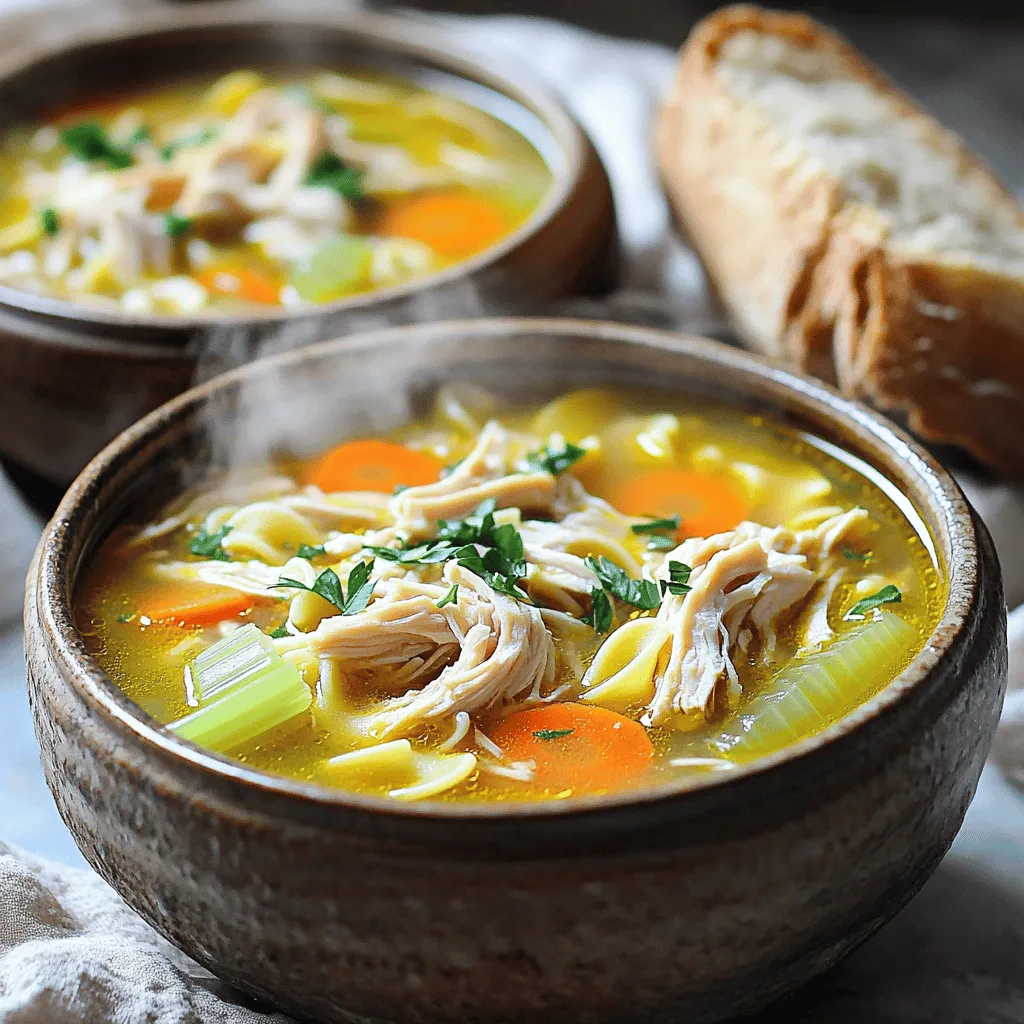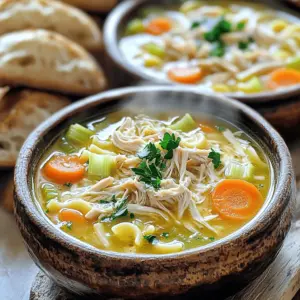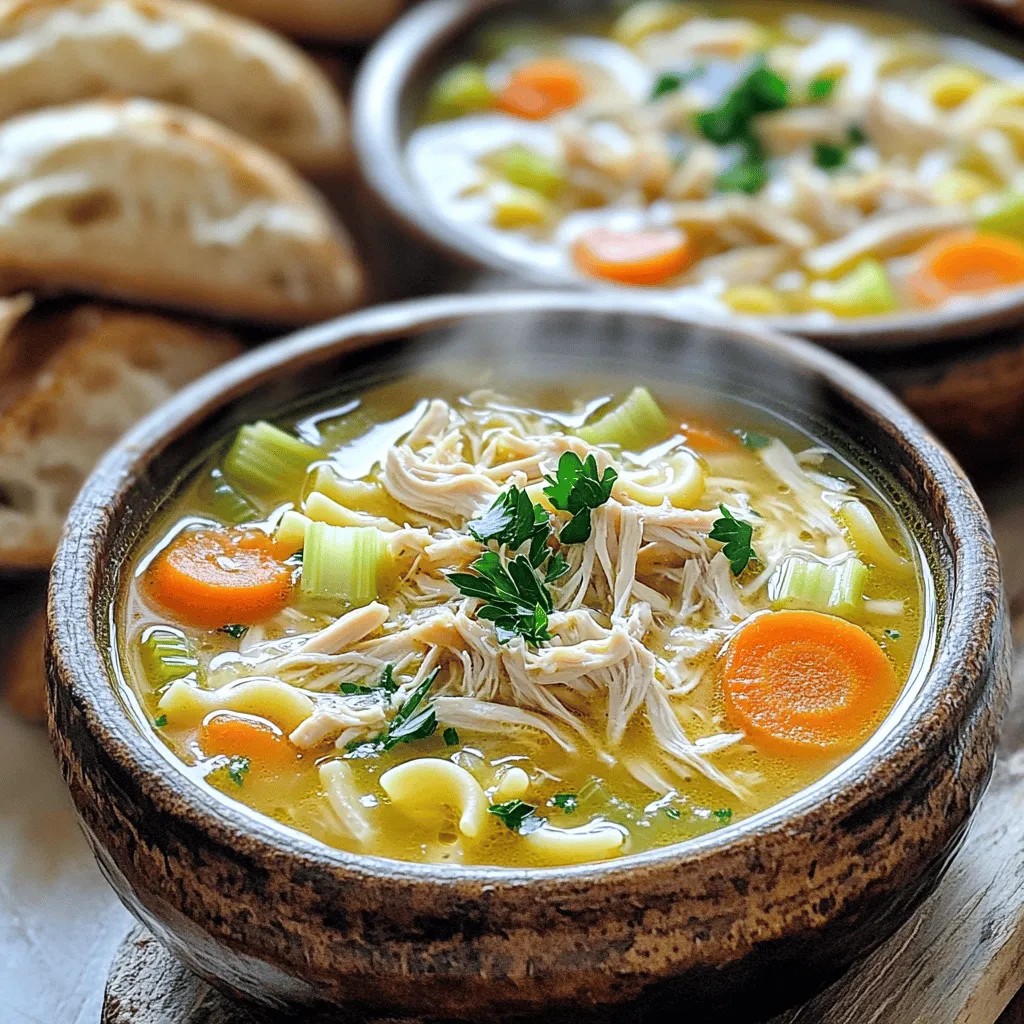When you crave comfort, nothing beats a bowl of Slow Cooker Chicken Noodle Soup. This easy recipe lets your slow cooker do the work while you enjoy tasty flavors and cozy warmth. I’ll guide you through each step, from layering fresh ingredients to adding the perfect seasonings. Whether you’re feeding a family or just treating yourself, this soup brings deliciousness to every table. Let’s dive into making this comforting classic!
Ingredients
When making Slow Cooker Chicken Noodle Soup, you need fresh, simple ingredients. Each one adds flavor and warmth to the dish. Here’s what you will need:
– 1 pound boneless, skinless chicken breasts
– 4 cups low-sodium chicken broth
– 2 cups water
– 1 medium onion, diced
– 3 cloves garlic, minced
– 3 medium carrots, sliced
– 2 stalks celery, sliced
– 2 teaspoons dried thyme
– 1 teaspoon dried oregano
– 1 bay leaf
– Salt and pepper to taste
– 4 ounces egg noodles
– 1 cup frozen peas
– Fresh parsley, chopped (for garnish)
Each ingredient plays a crucial role. The chicken provides protein, while the broth builds a savory base. Onions and garlic create a fragrant foundation. Carrots and celery add natural sweetness and crunch. Thyme and oregano bring in herbal notes, enhancing the soup’s warmth. The noodles make it hearty, and peas add a pop of color and sweetness.
You can find the full recipe to guide you through the cooking process. Enjoy crafting this comforting dish!
Step-by-Step Instructions
Preparation Steps
To make this soup, start by layering the ingredients. Place the chicken breasts at the bottom of the slow cooker. This gives a solid base for the soup. Next, pour in 4 cups of low-sodium chicken broth and 2 cups of water. Make sure the chicken is fully covered.
Now, add the diced onion, minced garlic, sliced carrots, and sliced celery. Spread them evenly over the liquids. This layering adds great flavor. Then, sprinkle in the dried thyme, dried oregano, a bay leaf, and a good pinch of salt and pepper.
Cooking Times
For cooking, you have two options: low heat or high heat. If you choose low heat, cook for 6-8 hours. For high heat, cook for 4-5 hours. The chicken should be tender enough to shred easily.
When it’s almost done, add the egg noodles and frozen peas. It’s best to add these 20-30 minutes before you finish cooking. This way, the noodles cook perfectly without getting mushy.
Final Touches
Once the chicken is cooked, remove it from the slow cooker. Use two forks to shred the chicken into bite-sized pieces. Then, return the shredded chicken to the soup. Stir it in well.
Before serving, taste the soup. You might need to adjust the seasoning with more salt and pepper. Don’t forget to remove the bay leaf! For a fresh touch, sprinkle chopped parsley on top. This adds color and brightness to your comforting dish.
Tips & Tricks
Enhancing Flavor
Suggested Seasoning Adjustments
To boost flavor, think about adding a splash of lemon juice. It brightens the soup. You can also mix in a teaspoon of smoked paprika for depth. If you love spice, a pinch of cayenne adds a nice kick. Taste your soup before serving. Adjust with more salt or pepper if needed.
Adding Fresh Herbs
Fresh herbs make a big difference. Try adding thyme or dill right at the end. Chopped parsley adds color and freshness. You can also add fresh basil for a unique twist. Just remember to add them just before serving to keep their flavor bright.
Cooking with a Slow Cooker
Benefits of Slow Cooking
Slow cooking lets flavors blend nicely. It makes tough cuts of meat tender. You don’t need to stand by the stove. Just set it and forget it. Plus, it fills your home with a cozy aroma.
Common Mistakes to Avoid
Avoid lifting the lid too often. Each time you do, heat escapes. This can extend cooking time. Also, be careful not to overfill your slow cooker. Leave some space for steam. Lastly, always check your slow cooker’s manual for specific cooking times.
Serving Suggestions
Ideal Accompaniments
Serve your soup with crusty bread for a filling meal. A fresh green salad pairs well too. If you want more flavor, try a sprinkle of grated cheese on top. This makes each bite even better.
Presentation Tips
When serving, use deep bowls for a hearty look. Ladle in the soup and then add a sprinkle of parsley. This adds a nice splash of green. You can also offer lemon wedges on the side. This allows guests to add a zing if they wish.

Variations
Ingredient Substitutions
Using Different Proteins
You can switch the chicken for other proteins. Try turkey for a lighter dish. If you prefer beef, use stew meat. For a fun twist, add shrimp in the last hour of cooking. Each protein brings its own taste, making the soup unique.
Vegetarian Alternatives
If you want a meatless option, use chickpeas or lentils. Both add protein and heartiness. Replace chicken broth with vegetable broth for flavor. You can also add more veggies. Consider mushrooms, zucchini, or bell peppers. These choices keep the soup rich and filling.
Flavor Twists
Adding Spices or Heat
To spice things up, add red pepper flakes or cayenne. This gives a nice kick without being too spicy. You can also try fresh herbs like dill or basil for a fresh taste. Experimenting with flavors can make your soup special.
Creamy Version vs Traditional
For a creamy version, stir in some heavy cream or coconut milk at the end. This adds a rich texture and taste. If you like the traditional style, stick to the original recipe. Both versions are delicious in their own way.
For more ideas, check out the Full Recipe for additional tips and variations.
Storage Info
Storing Leftovers
– Best Containers for Storing Soup: Use airtight containers. Glass containers work well since they won’t stain. If you use plastic, ensure it is BPA-free.
– Refrigeration and Freezing Tips: Store leftover soup in the fridge for up to four days. For longer storage, freeze the soup. Cool it to room temperature before freezing. Use freezer-safe bags or containers for easy storage. Leave some space at the top, as soup expands when frozen.
Reheating Guidelines
– Recommended Methods: To reheat, use a pot on the stove. Stir the soup often for even heating. You can also use the microwave. Heat in a microwave-safe bowl, stirring every minute for the best results.
– Keeping Noodles from Getting Soggy: If you freeze the soup, add the noodles fresh when reheating. This keeps them firm. If you have leftovers with noodles, add a splash of broth when reheating. This helps maintain their texture.
FAQs
Common Questions
How to make Slow Cooker Chicken Noodle Soup gluten-free?
To make this soup gluten-free, use gluten-free noodles. You can find many brands that offer tasty options. Also, ensure the chicken broth is labeled gluten-free. This keeps your soup safe and delicious.
Can I add other vegetables?
Absolutely! You can add vegetables like corn, green beans, or bell peppers. Just chop them small so they cook well. Feel free to mix and match based on what you like.
How long does Slow Cooker Chicken Noodle Soup last in the fridge?
This soup can last in the fridge for about 3-4 days. Store it in an airtight container for best results. Reheat it on the stove or in the microwave until hot.
Ingredient-Specific Inquiries
What type of chicken works best?
Boneless, skinless chicken breasts work best for this recipe. They cook evenly and shred easily. You can also use thighs for a richer flavor, but the cooking time may vary.
Can I use fresh instead of frozen peas?
Yes, you can use fresh peas! Just add them in the last few minutes of cooking. This way, they stay bright and tender.
Cooking Technique Queries
Is it necessary to sauté vegetables first?
No, it’s not necessary to sauté the vegetables. Adding them raw allows them to cook slowly and soak up flavors. This saves time and makes it easier.
How do I know when the chicken is cooked through?
The chicken is cooked when it reaches 165°F. You can check this with a meat thermometer. If you don’t have one, look for the chicken to be white and no longer pink inside.
In this blog post, we covered making Slow Cooker Chicken Noodle Soup. We discussed the key ingredients, step-by-step instructions, and cooking times. You learned tips for enhancing flavors and ways to customize your soup. We also explored storage methods and answered common questions.
This soup is easy to make and tasty. With the right tools and tips, you can enjoy a warm bowl every time. Try it today and enjoy!

